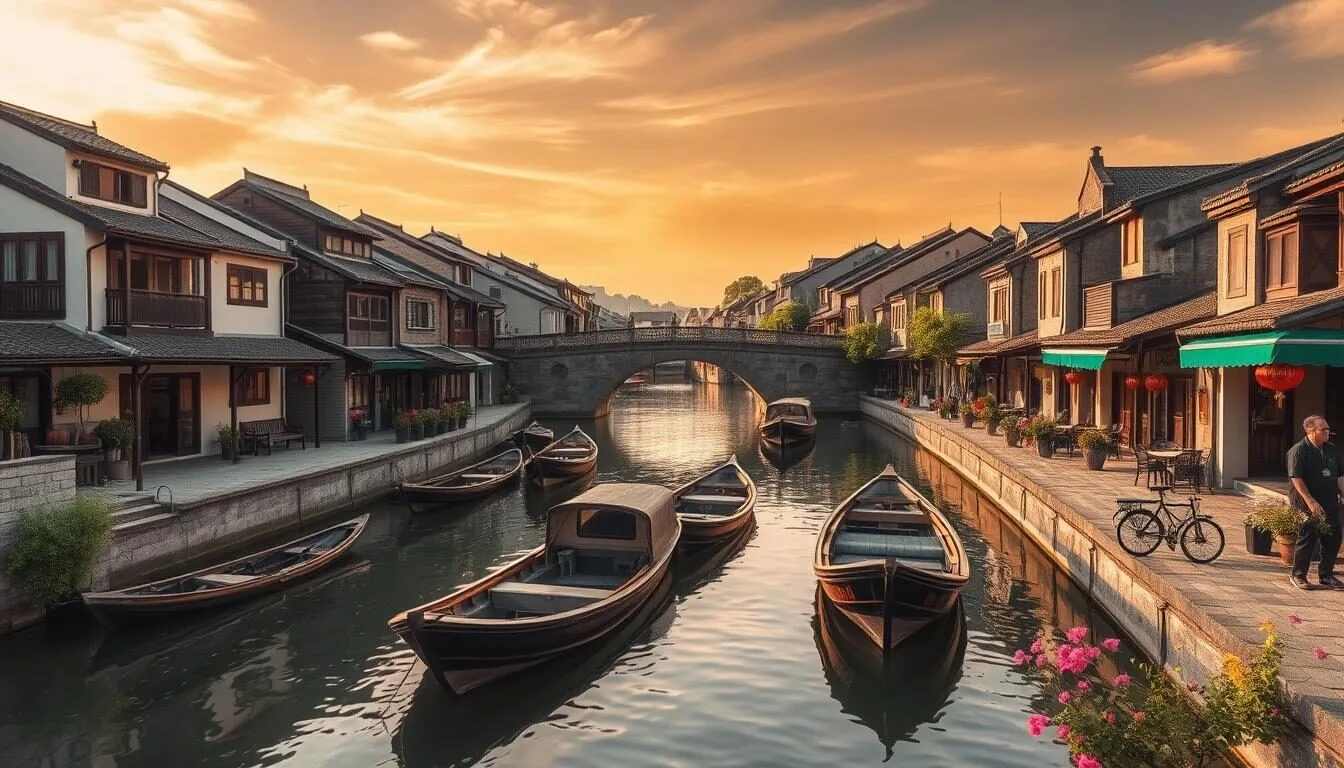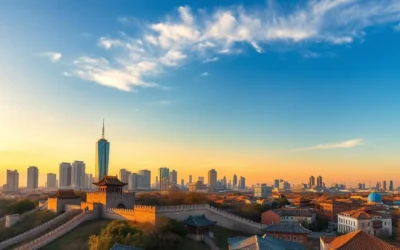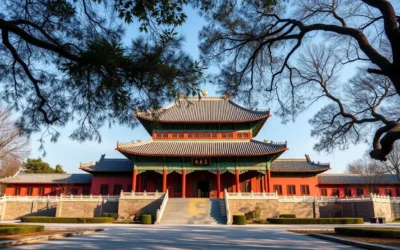✓ Accommodations✓ Flights✓ Rental Cars✓ Tours & Activities
Imagine stepping into a charming ancient water town that’s just a short trip from the bustling metropolis of Shanghai. With its 1,700-year-old history and picturesque canals, Zhujiajiao is a must-visit destination for anyone looking to experience the authentic beauty of.
Located just 48 kilometers west of Shanghai, this enchanting water town offers a perfect escape from the city’s chaos. As you wander through its winding canals and ancient bridges, you’ll discover the rich history and cultural heritage that makes Zhujiajiao so unique.
In this comprehensive guide, you’ll find the top attractions and insider tips to make the most of your trip to Zhujiajiao. Whether you’re looking for a relaxing day trip or an action-packed adventure, this guide has got you covered.
Discovering Zhujiajiao Water Town: Shanghai’s Venice
Located just 50 km from the Bund in Shanghai, Zhujiajiao Water Town is a hidden gem waiting to be explored. You can experience the charm of ancient China without traveling far from the city. With its rich history, picturesque canals, and well-preserved architecture, Zhujiajiao is an ideal destination for those seeking a cultural and tranquil escape.
History and Background of the 1,700-Year-Old Town
Zhujiajiao’s history dates back over 1,700 years, with its origins tracing back to the Yuan Dynasty. It was a significant trading hub due to its strategic location along the canals. You can still see the remnants of its past glory in the form of ancient bridges, temples, and traditional Chinese residences. The town’s history is palpable as you stroll along its waterways, making it a fascinating place to explore.
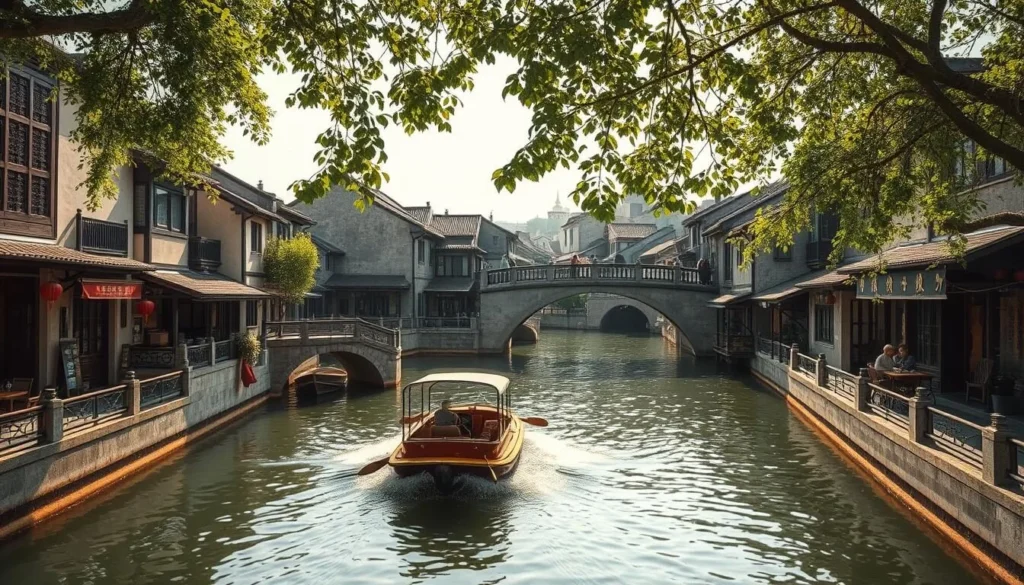
Why Zhujiajiao Stands Out Among Water Towns
What sets Zhujiajiao apart from other water towns is its sheer size and the comprehensiveness of its traditional Jiangnan water town culture. Spanning 47 square kilometers, it is one of the largest and most well-preserved ancient towns around Shanghai. You will appreciate the layout of the town, with its 36 stone bridges and multiple waterways, creating a picturesque landscape that has earned it the nickname “Venice of Shanghai.” The town’s ability to maintain its traditional character while evolving into a commercial center is a testament to its enduring charm.
As you explore Zhujiajiao, you’ll discover why it’s a favorite among visitors. Its unique blend of history, culture, and natural beauty makes it a must-visit destination. You can enjoy a boat ride along the canals, visit ancient temples, and experience the local cuisine, making for a well-rounded and memorable trip.
How to Get to Zhujiajiao from Shanghai

Getting to Zhujiajiao from Shanghai is easier than you think, with multiple transportation options available. You can choose from metro, bus, or private transfer, depending on your budget, time constraints, and comfort preferences.
By Metro: Line17 Route
Take Shanghai Metro Line17 and get off at Zhujiajiao Station. From there, you can either walk for about 20-30 minutes to the entrance or take a local bus that drops you off right at the town’s main gate.
By Tourist Bus: Direct Routes
There are direct tourist buses operating from Shanghai Stadium (Gate5) and Pu’an Road Bus Station. The bus ride takes about an hour and costs just 12 yuan, making it an economical option.
By Private Transfer: Convenience Option
If you prefer a more comfortable journey, consider taking a private transfer or taxi. The trip from downtown Shanghai to Zhujiajiao Water Town costs around 200 yuan. You can also use ride-hailing apps like Didi for a seamless experience.
Understanding the pros and cons of each transportation method will help you make an informed decision. Whether you’re looking for convenience, economy, or comfort, there’s an option for you.
Fangsheng Bridge: The Iconic Landmark
As you explore Zhujiajiao, you’ll encounter numerous historical landmarks, but none as iconic as Fangsheng Bridge. This ancient bridge is not only a significant part of Zhujiajiao’s history but also a symbol of the town’s cultural heritage.
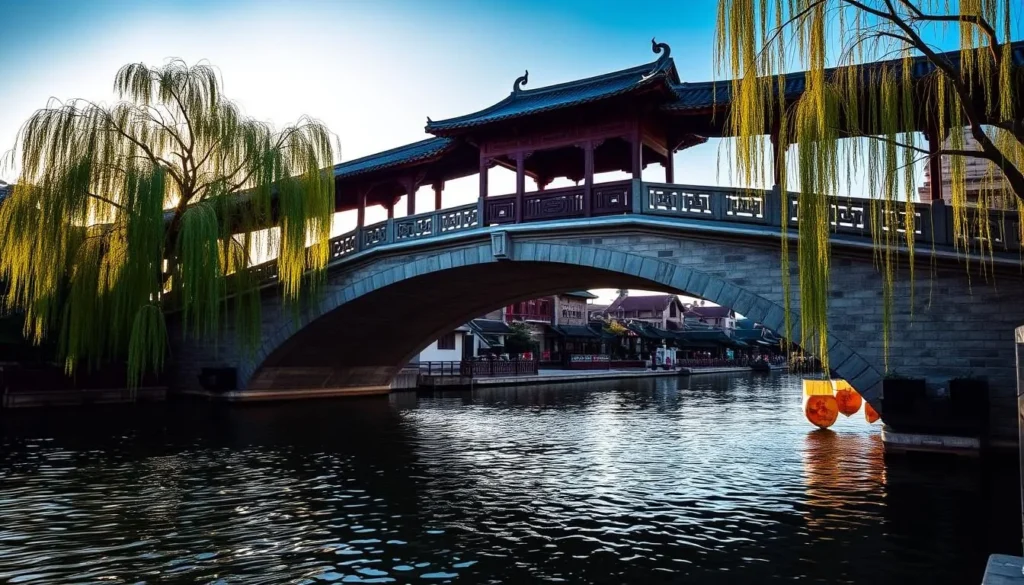
History of the “Life-Releasing Bridge”
Fangsheng Bridge, built in 1571, stands across the Caogang River, linking the north and south parts of Zhujiajiao. The name “Fangsheng” or “releasing life” reflects its historical role as a site where monks and Buddhists would gather to free captive animals as an act of compassion. With a length of 70.8 meters, a width of 5.8 meters, and a height of 7.4 meters, it is renowned as the “No.1 Bridge of Shanghai.”
Best Photography Spots
The bridge offers a picturesque view of Ming-Qing-style architecture, with whitewashed walls and black-tiled roofs lining the riverbanks, complemented by traditional boats gliding along the water. For photography enthusiasts, the bridge is a perfect spot, especially during golden hour when the light creates magical reflections on the canal waters. You can capture the majestic structure of the bridge against the backdrop of traditional buildings.
Visiting Fangsheng Bridge allows you to experience the essence of Zhujiajiao, surrounded by bridges that have stood the test of time. It’s a moment to appreciate the architectural marvel and the cultural significance of this iconic landmark.
Exploring Kezhi Garden and Its Cultural Significance
As you wander through Zhujiajiao, you’ll discover the serene beauty of Kezhi Garden, a masterpiece of traditional Chinese landscaping. This garden, dating back to 1912, is a significant cultural attraction in the ancient town, covering an impressive 96.7 hectares.
The Blend of Chinese and Western Architecture
Kezhi Garden is renowned for its unique blend of Chinese and Western architectural styles. The garden features over 200 meticulously arranged buildings and living quarters, creating a harmonious balance between traditional and modern elements. The landmark of the gardens is a five-story building with a pavilion on its roof, the tallest structure in the ancient town of Zhujiajiao.
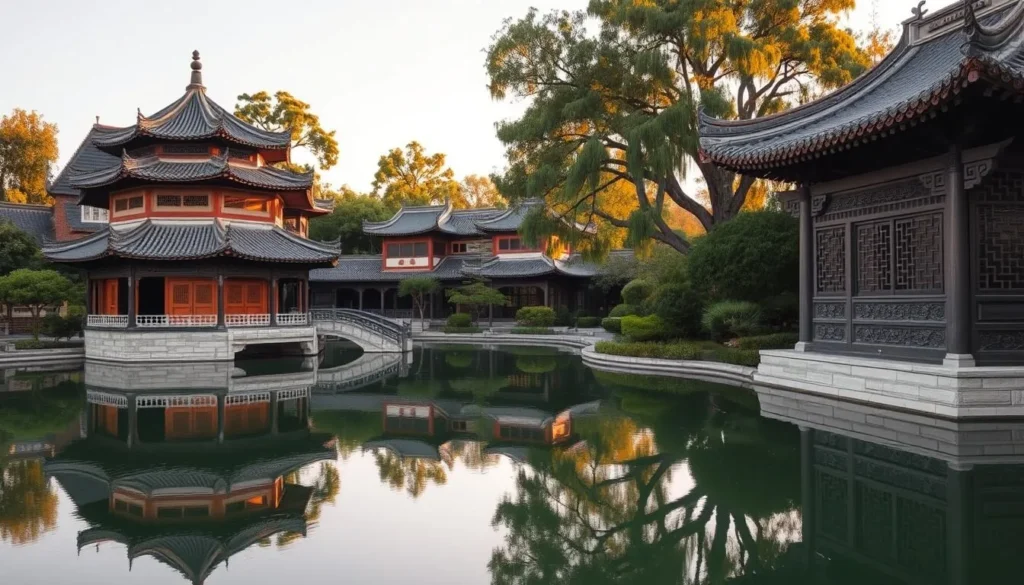
Highlights Within the Garden
The garden is divided into three distinct sections: the residential area, the rockery area, and the garden area. You can explore replicas of iconic structures such as the Zigzag Bridge from Shanghai’s Yu Garden and the Lion Pavilion from Suzhou’s Lion Grove Garden, showcasing the finest elements of classical Jiangnan architecture and garden design. The name “Kezhi” means “to learn to plant,” reflecting the garden’s original purpose as a place for botanical education and appreciation.
| Section | Description | Notable Features |
|---|---|---|
| Residential Area | Living quarters and traditional housing | Meticulously arranged buildings |
| Rockery Area | Artificial hills and stone formations | Unique rock structures |
| Garden Area | Meticulously designed garden | Replicas of famous structures |
Visiting Kezhi Garden offers a deep insight into Zhujiajiao’s cultural heritage and its significance as a major attraction. The garden’s blend of architectural styles and its historical importance make it a must-visit destination when exploring the ancient town.
Strolling Along North Street: Zhujiajiao’s Ancient Thoroughfare
Strolling along North Street in Zhujiajiao is like stepping back in time, with its remarkably preserved ancient architecture and lively atmosphere. This street is the most well-preserved Ming-Qing Dynasty thoroughfare in Shanghai and the heart of Zhujiajiao’s ancient town.
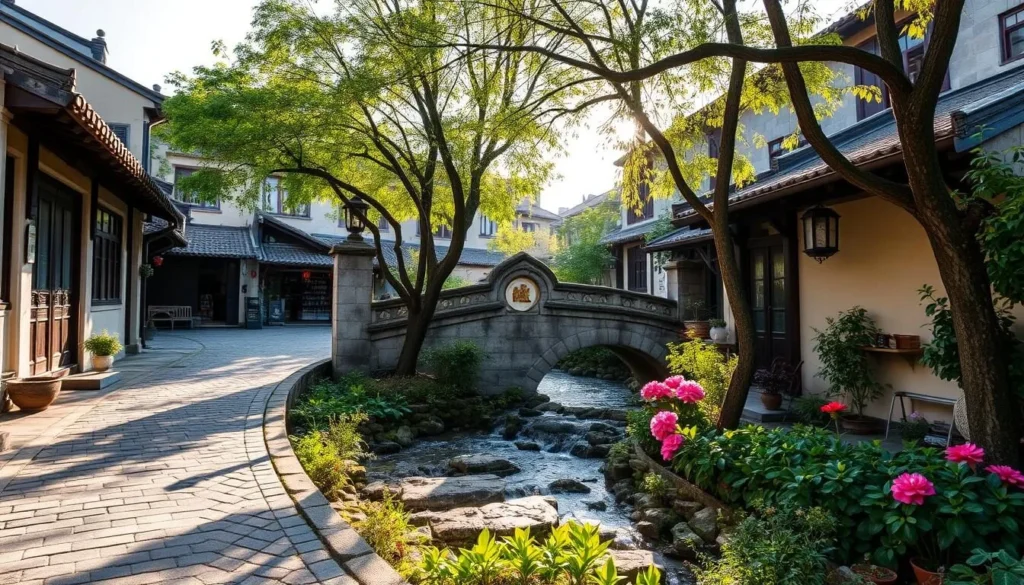
Ming-Qing Dynasty Architecture
The buildings along North Street date back to the Qing Dynasty era (1644-1912), showcasing distinctive wooden facades, stone foundations, and traditional Chinese design elements. As you walk along the stone-paved street, you’ll be immersed in the historic ambiance.
Traditional Shops and Local Specialties
North Street is lined with a vibrant mix of traditional shops and modern establishments. You can explore century-old brand shops like Club Teahouse, Handalong Sauce, and Pickles Shop, and sample local specialties from street vendors and small eateries. The street’s unique layout creates a frame for the sky above, earning it the nickname “A Street of Finedraw.”
| Experience | Description |
|---|---|
| Leisurely Stroll | Take a leisurely stroll along North Street, admiring the ancient architecture. |
| Local Specialties | Sample local snacks and delicacies from street vendors and eateries. |
| Traditional Shops | Explore century-old brand shops and modern establishments. |
Zhujiajiao, China: Best Things to Do – Top Picks for Cultural Immersion
As you explore Zhujiajiao, you’ll uncover a rich cultural heritage that is reflected in its historic landmarks and traditional practices. The town is home to numerous cultural attractions that offer a glimpse into its fascinating history.
City God Temple and Its Three Treasures
The City God Temple, a significant Taoist sacred site in Shanghai, is dedicated to protecting the wellness and happiness of local residents. Upon entering the temple, you’ll be greeted by a screen wall depicting “The Eight Immortals Crossing the Sea” and a pair of intricately carved stone lions. The temple is also home to three treasures:
- an old drama stage where traditional performances were held,
- a large abacus symbolizing prosperity, and
- a majestic hundred-year-old gingko tree.
These treasures are a testament to the temple’s rich cultural significance.
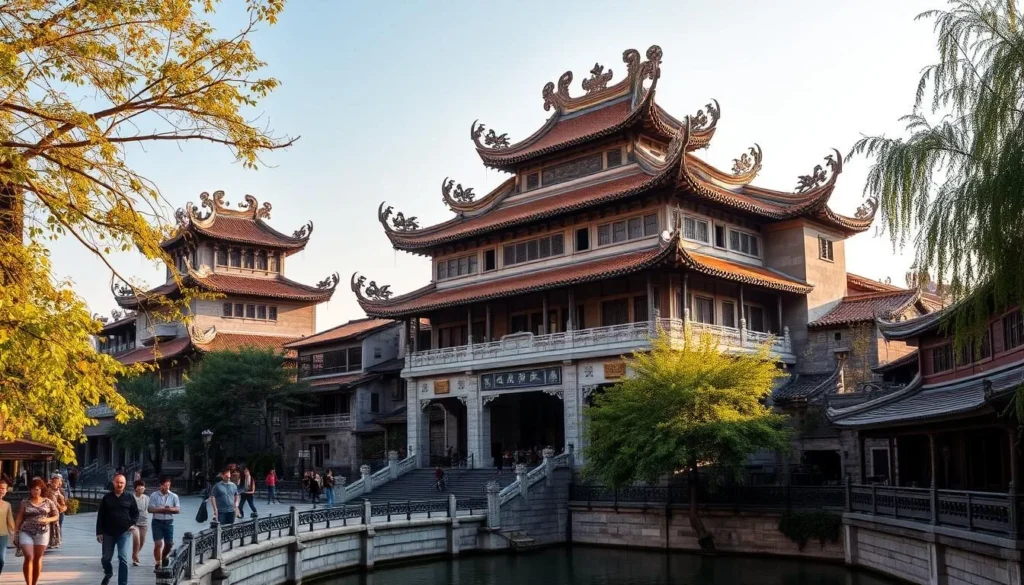
Qing Dynasty Post Office: A Glimpse into Postal History
For a unique insight into China’s postal history, visit the Qing Dynasty Post Office, established in 1903. This post office is recognized as the best-preserved postal facility from the Qing Dynasty era in China. The exhibition hall features a fascinating collection of postal artifacts, including ancient letters written on bamboo strips and antique postcards depicting old Shanghai. These exhibits provide a glimpse into the evolution of communication methods during the late Qing Dynasty.
Some of the key highlights of the Qing Dynasty Post Office include:
- Ancient letters written on bamboo strips,
- Antique postcards representing the living conditions and folk customs of different social strata,
- A thousand-year history of China’s postal service.
By visiting these cultural attractions, you’ll gain a deeper understanding of Zhujiajiao’s rich heritage and the significance of its historic landmarks.
Taking a Scenic Boat Ride Through the Canals
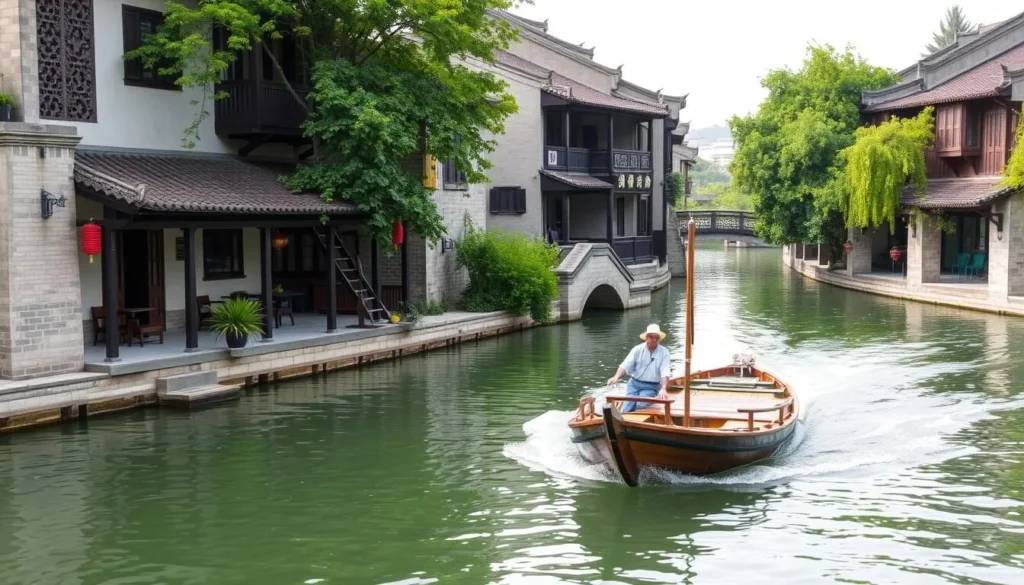
Experience the essence of Zhujiajiao by taking a leisurely boat ride along its historic waterways. The town’s picturesque canals are best explored at a relaxed pace, allowing you to soak in the serene atmosphere and admire the traditional architecture.
Popular Boating Routes
Travelers can choose from several popular boating routes that showcase the town’s highlights. Common routes include Fangsheng Bridge to Kezhi Garden, City God Temple to Kezhi Garden, and Kezhi Garden to Fangsheng Bridge. Each route offers a unique perspective on Zhujiajiao’s canals and historic landmarks.
Cost and Practical Information
The cost of a boat ride varies depending on the route. A short-distance trip costs about 80 yuan per boat for approximately 10 minutes, while a long-distance cruise costs 150 yuan per boat. Tickets can be purchased at small wooden ticket booths located near the docks. You can board your boat at one of the four main piers: near Fangsheng Bridge, Kezhi Garden, City God Temple, or North Street.
Hidden Gems: Lesser-Known Attractions
Among Zhujiajiao’s winding canals and ancient architecture, lie several hidden gems that are waiting to be uncovered by curious travelers. While the town’s popular tourist spots are undoubtedly charming, it’s the lesser-known attractions that offer a more serene and authentic experience.
The Garden of Inseparable Hearts
The Garden of Inseparable Hearts, also known as Hexin Garden, is a private museum and classical Chinese garden spanning 3,000 square meters. This hidden gem blends Jiangnan water town aesthetics with imperial artifacts, presenting priceless collections from the Ming and Qing dynasties. Visitors can admire the garden’s exquisite features, including the auspicious “Purple Dawn from the East” brick-carved gate tower and the striking emerald-green, double-tiered Hexin Pavilion.
Yuan Jin Buddhist Temple
Founded in 1341 during the Yuan Dynasty, the Yuan Jin Buddhist Temple is a revered Buddhist cultural sanctuary with over 600 years of spiritual heritage. The temple is often referred to as “Niang Niang Temple” due to its enshrinement of Avalokitesvara Bodhisattva. Travelers can explore the peaceful temple by visiting the Maitreya Hall, Hall of Three Saints, Yongyue Well, Yuantong Treasure Hall, and Qinghua Pavilion, each housing meticulously crafted Buddhist treasures.
Shanghai Helong Art Gallery
The Shanghai Helong Art Gallery is a contemporary art space that showcases traditional and modern Chinese artworks, including calligraphy and paintings. Located within the ancient water town, the gallery offers a cultural contrast to Zhujiajiao’s historic charm, making it a unique stop for art enthusiasts. By visiting these lesser-known attractions, you can experience a more peaceful and culturally immersive visit to Zhujiajiao.
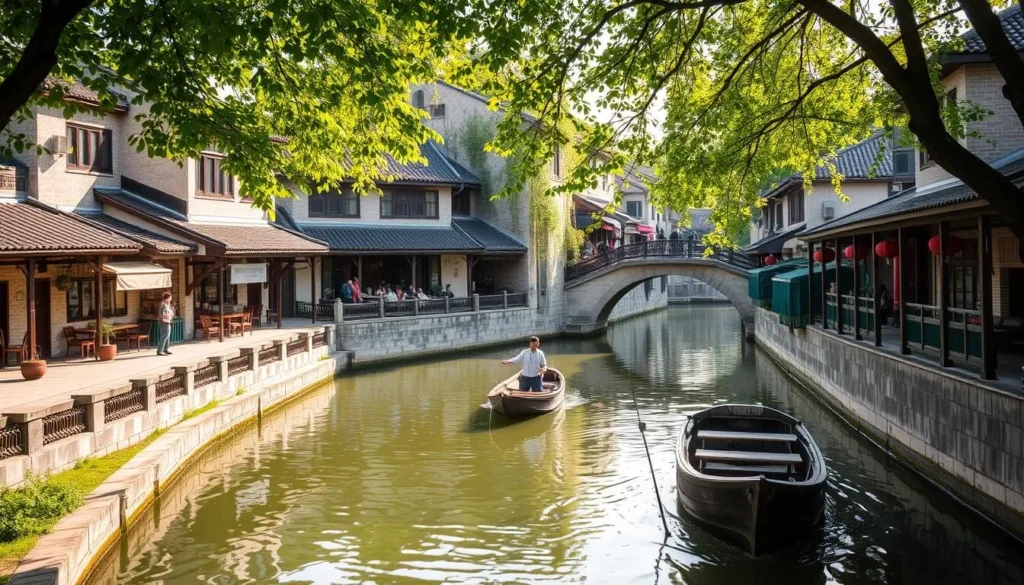
Practical Information for Your Visit
To make the most of your trip to Zhujiajiao Water Town, it’s essential to plan ahead with the right practical information. Understanding the basics can significantly enhance your experience, allowing you to enjoy the town’s charm without unnecessary hassles.
Entrance Fees and Pass Options
At the entrance, you’ll need to buy an all-day pass, which grants access to various attractions. There are different passes available depending on how many places you want to visit. Route 1 costs 40 RMB ($5.5) and covers 3 attractions, while Route 2 costs 80 RMB ($11) and covers 5 attractions. It’s worth noting that entry to the town itself is free.
| Pass Type | Price (RMB) | Price (USD) | Attractions Covered |
|---|---|---|---|
| Route 1 | 40 | $5.5 | 3 |
| Route 2 | 80 | $11 | 5 |
Opening Hours and Best Time to Visit
The best time to visit Zhujiajiao Water Town is during the spring (March to May) and autumn (September to November) months when the weather is mild, and the scenery is at its most picturesque. Summers can be hot and humid, whilst winters tend to be chilly and less scenic. If you want to avoid the crowds, plan your trip on a weekday morning, ideally before 10 AM.
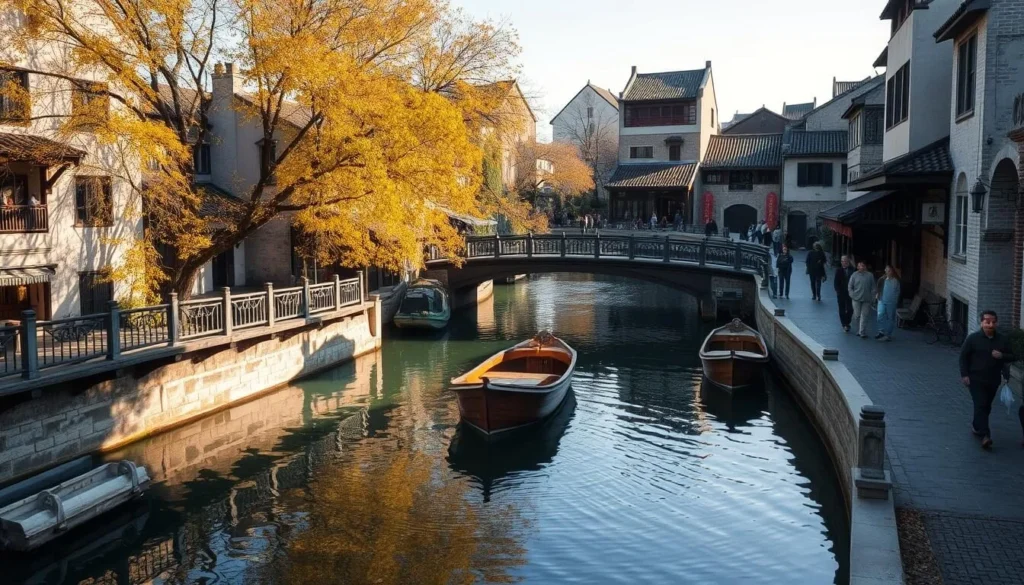
Recommended Routes Through the Town
For a half-day walking itinerary, consider the “Essence Walking Route” that covers 5 paid attractions. You can stroll along its ancient canals, stone bridges, and narrow lanes. The route includes: Tourist Center – Kezhi Garden – Hexin Garden – Yongan Bridge – Apo Teahouse – Fangsheng Bridge – North Street – Shanghai Helong Art Gallery – Taian Bridge – Yuanjin Buddhist Temple – City God Temple – Post Office of Qing Dynasty – Tourist Center.
Alternatively, consider combining walking and boating for a more comprehensive experience, allowing you to see Zhujiajiao from both land and water perspectives.
Where to Eat and Drink in Zhujiajiao
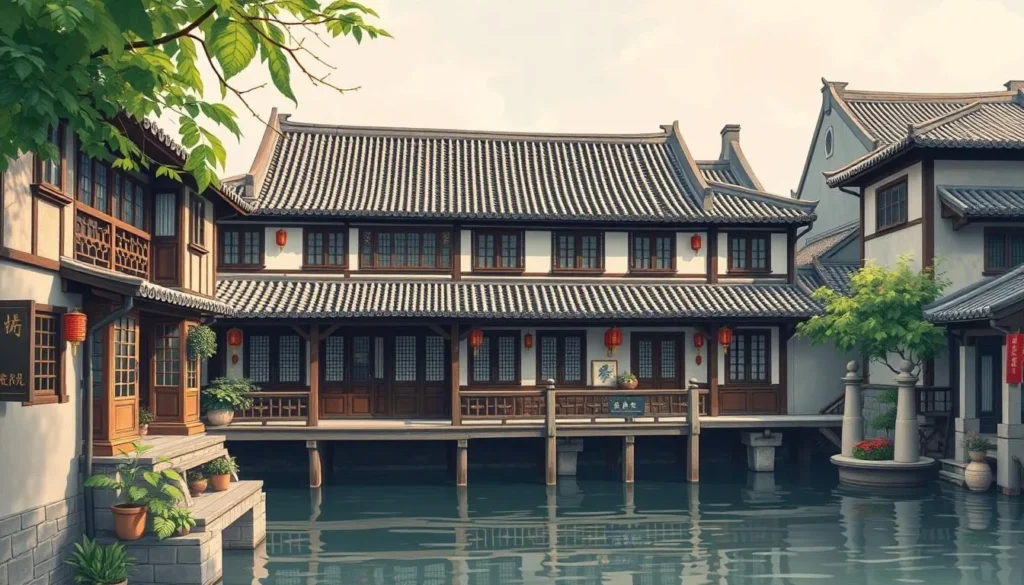
From traditional teahouses to modern cafes, Zhujiajiao has something for every palate. As you explore this ancient water town, you’ll discover a diverse range of dining options to satisfy your cravings.
Traditional Teahouses
Experience authentic Chinese tea culture at traditional teahouses like Club Teahouse, where you can sample various teas while enjoying views of the canals and ancient architecture. This is a great way to relax and immerse yourself in the local culture.
Local Delicacies to Try
Be adventurous and try the local delicacies available from street vendors along North Street, including options like pork and chicken feet, crispy pork belly, and even edible insects. You’ll find a variety of food options to suit your taste.
Cafes and Western Options
Relax at one of the trendy cafes that have established themselves in historic buildings, offering a fusion of East and West with quality coffee. You can also visit one of the unique “cat cafes” or pet-friendly establishments where you can enjoy your beverage in the company of furry friends.
As you eat and drink your way through Zhujiajiao, be sure to explore the many shops selling local snacks, handicrafts, and souvenirs. With a little planning, you can have a culinary adventure that complements your exploration of this charming water town.
Conclusion: Making the Most of Your Zhujiajiao Day Trip
To truly enjoy your day trip to Zhujiajiao, it’s essential to plan strategically. Arriving early in the morning helps you avoid crowds, and allocating at least 4-6 hours allows you to fully appreciate this charming water town.
A well-rounded experience can be achieved by combining major highlights like Fangsheng Bridge, Kezhi Garden, and North Street with lesser-known gems such as the Garden of Inseparable Hearts and Yuan Jin Buddhist Temple. Don’t miss the opportunity to see Zhujiajiao from a different perspective by taking a scenic boat ride through its canals.
Consider visiting on a weekday to avoid the crowds that flock to Zhujiajiao during weekends and Chinese holidays. Wear comfortable walking shoes to navigate the stone streets, and be prepared with both cash and digital payment options for a smooth experience.
Take your time to absorb the atmosphere, sit by the canals, and watch local people going about their daily lives. Zhujiajiao offers a perfect contrast to Shanghai’s futuristic skyline, providing travelers with a balanced view of China’s rich history and rapid modernization.
The above is subject to change.
Check back often to TRAVEL.COM for the latest travel tips and deals.
